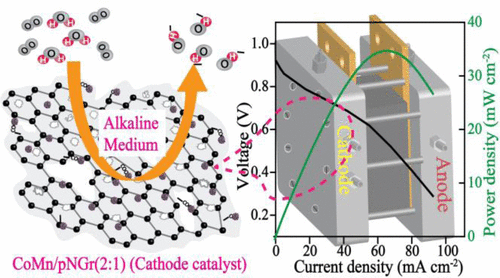当前位置:
X-MOL 学术
›
ACS Catal.
›
论文详情
Our official English website, www.x-mol.net, welcomes your
feedback! (Note: you will need to create a separate account there.)
Efficient and Durable Oxygen Reduction Electrocatalyst Based on CoMn Alloy Oxide Nanoparticles Supported Over N-Doped Porous Graphene
ACS Catalysis ( IF 11.3 ) Pub Date : 2017-09-06 00:00:00 , DOI: 10.1021/acscatal.7b01983 Santosh K. Singh 1, 2 , Varchaswal Kashyap 1, 2 , Narugopal Manna 1, 2 , Siddheshwar N. Bhange 1, 2 , Roby Soni 1, 2 , Rabah Boukherroub 3 , Sabine Szunerits 3 , Sreekumar Kurungot 1, 2
ACS Catalysis ( IF 11.3 ) Pub Date : 2017-09-06 00:00:00 , DOI: 10.1021/acscatal.7b01983 Santosh K. Singh 1, 2 , Varchaswal Kashyap 1, 2 , Narugopal Manna 1, 2 , Siddheshwar N. Bhange 1, 2 , Roby Soni 1, 2 , Rabah Boukherroub 3 , Sabine Szunerits 3 , Sreekumar Kurungot 1, 2
Affiliation

|
Transition metal oxide derived materials are very important for various applications, such as electronics, magnetism, catalysis, electrochemical energy conversion, and storage. Development of efficient and durable catalysts for the oxygen reduction reaction (ORR), an important reaction in fuel cells and metal–air batteries, is highly desirable. Moreover, the futuristic catalysts for these applications need to be cost-effective in order to ensure a competitive edge for these devices in the energy market. This article describes the synthesis of a cost-effective and efficient electrocatalyst for ORR. It is based on supporting CoMn alloy oxide nanoparticles on N-doped porous graphene through a simple and scalable microwave irradiation method. Microwave irradiation was found to be very crucial for the fast creation of pores in the graphene framework with a concomitant formation of the CoMn alloy oxide nanoparticles. A series of catalysts have been synthesized by varying the Co:Mn ratio, among which, the one with the Co:Mn ratio of 2:1 [designated as CoMn/pNGr(2:1)] displayed remarkably higher ORR activity in 0.1 M KOH solution. It showed a ∼60 mV potential shift with a low Tafel slope of 74 mV/decade, which is comparable to that derived from the commercial Pt/C catalyst. This high activity of CoMn/pNGr(2:1) has been credited to the cooperative effect arising from the metal entities and the defects present in the N-doped porous graphene. Finally, real system-level validations of the use of CoMn/pNGr(2:1) as cathode catalyst could be performed by fabricating and testing single-cells of an anion-exchange membrane fuel cell (AEMFC) and a primary Zn–air battery, which successfully demonstrated the efficiency of the catalyst to facilitate ORR in real integrated systems of the single-cell assemblies.
中文翻译:

N掺杂多孔石墨烯负载CoMn合金氧化物纳米粒子的高效耐用减氧电催化剂
过渡金属氧化物衍生的材料对于各种应用非常重要,例如电子,磁性,催化,电化学能量转换和存储。迫切需要开发一种高效耐用的氧还原反应(ORR)催化剂,该反应是燃料电池和金属空气电池中的重要反应。此外,用于这些应用的未来催化剂必须具有成本效益,以确保这些设备在能源市场上的竞争优势。本文介绍了一种用于ORR的经济高效的电催化剂的合成方法。它基于通过简单且可扩展的微波辐照方法将CoMn合金氧化物纳米颗粒负载在N掺杂的多孔石墨烯上。发现微波辐射对于在石墨烯框架中同时形成CoMn合金氧化物纳米颗粒的快速形成孔非常关键。通过改变Co:Mn比合成了一系列催化剂,其中,Co:Mn比为2:1的催化剂(称为CoMn / pNGr(2:1))在0.1 M中显示出显着更高的ORR活性。 KOH溶液。它显示出约60 mV的电势漂移,Tafel斜率低,为74 mV /十倍,这可与商用Pt / C催化剂得到的相当。CoMn / pNGr(2:1)的这种高活性已归因于金属实体和N掺杂多孔石墨烯中存在的缺陷引起的协同效应。最后,使用CoMn / pNGr(2:
更新日期:2017-09-07
中文翻译:

N掺杂多孔石墨烯负载CoMn合金氧化物纳米粒子的高效耐用减氧电催化剂
过渡金属氧化物衍生的材料对于各种应用非常重要,例如电子,磁性,催化,电化学能量转换和存储。迫切需要开发一种高效耐用的氧还原反应(ORR)催化剂,该反应是燃料电池和金属空气电池中的重要反应。此外,用于这些应用的未来催化剂必须具有成本效益,以确保这些设备在能源市场上的竞争优势。本文介绍了一种用于ORR的经济高效的电催化剂的合成方法。它基于通过简单且可扩展的微波辐照方法将CoMn合金氧化物纳米颗粒负载在N掺杂的多孔石墨烯上。发现微波辐射对于在石墨烯框架中同时形成CoMn合金氧化物纳米颗粒的快速形成孔非常关键。通过改变Co:Mn比合成了一系列催化剂,其中,Co:Mn比为2:1的催化剂(称为CoMn / pNGr(2:1))在0.1 M中显示出显着更高的ORR活性。 KOH溶液。它显示出约60 mV的电势漂移,Tafel斜率低,为74 mV /十倍,这可与商用Pt / C催化剂得到的相当。CoMn / pNGr(2:1)的这种高活性已归因于金属实体和N掺杂多孔石墨烯中存在的缺陷引起的协同效应。最后,使用CoMn / pNGr(2:











































 京公网安备 11010802027423号
京公网安备 11010802027423号